For anyone who thought that I might have disappeared, no such luck. ;)
And for anyone looking for something to do over the holidays with visiting family or friends, please remember that Kerry Wood Nature Centre is open every day (excepting Christmas Day itself), and that the trails in the Gaetz Lakes Sanctuary are accessible to the public even when the Nature Centre building is closed.
For more information on our holiday hours or upcoming events, don't hesitate to call us at (403) 346-2010.
A quick note to our staff bloggers: This blog has been switched to the new version of Blogger, which means that you'll have to sign in using a Google account from now on. For now, though, just sign in to post as you usually would. Blogger will give you instructions on how to create your new account.
Photos, program information, and general insights from the staff of the Kerry Wood Nature Centre.
Saturday, December 23, 2006
Monday, December 18, 2006
A looooooonnnnggg walk somewhere by Fox Lake
Snowmobiles. Some people like them, some don't. I followed a trail through the forest a couple of days made ago by them. The trail was wide enough for two snowmobiles side by side heading into the forest. I thought that it would lead back to Fox Lake turning back to the left. However after a very long walk, and the sun going down, I gave up trying to find Fox Lake by continuing the trail and decided to back track. I was thankful for the wide trail on the way back as it made it easier to tell which way was home in the dark. And I knew it would be a long walk back, I was hoping a snowmobile would stop by. But no luck. I saw lights and heard them in the distance. One was even coming my direction but then turned off into the forest. My legs were so sore the next day (turned out to be a 6-7 hour walk). So I still don't know how I feel about snowmobiles. I saw lots of tracks across the trail, even saw two critters at different instances scurry across from one side to the other. The first I think was a red squirrel as the tracks led from tree on side to a tree on the other but it was pretty far away so hard to say. Tracks looked squirrelish but not very identifiable. The second critter that scurried across was closer, a small brown plump little thing that climbed up little ledge of trail back into a hole under the snow. A shrew maybe? I saw mouse tracks further down the track leading from a tunnel to another tunnel. I saw a pair of pine grosbeaks, both male - they were so red, nice against the green - I should've known I wasn't getting that close to Fox Lake by the trees... it's pretty much all aspen around where I live, but this forest had quite the number of spruce trees amongst the aspen. On my way home, there was some big creature close by the trail too. I didn't get to see it, but I heard it - I must have scared it (it sure scared me, as hear this huge thrash right beside me, something running away knocking branches full of snow right by me). And it was too dark to look for tracks. I'm sure it is used to the few strange big things announcing itself from long off such as the noisy, bright snowmobiles. It was an experience, that's for sure :) A beautiful peaceful walk (I didn't see or hear any snowmobiles until after I wanted to see one, three quarters of the way back home so I really did get to enjoy a beautiful peaceful walk with safety from not getting lost by staying on the trail). Hopefully though, as suggested by my aching muscles, my next adventure is a bit shorter :)
Labels:
northern report
Tuesday, November 14, 2006
Frozen pay offs
Well I got a little lost in Fox Lake so my one hour walk turned into a four hour walk! Although frozen, I got to seem some really neat things... One of them was snow prints! Given the pairs of tracks, their size, and how far north we are, I am guessing it is the tracks of the least or short-tailed weasel - that's my best guess anyways. Sometimes snow can make identification hard because you can't see individual tracks very well. Then I saw a pine grosbeak, you could really see the red when it flew away and such a pretty song. Then I saw the most bizarre thing.. pink/red aspen trees. It looked like a big shaker from the sky had poured red powder on the trees. At closer inspection it was red flecks all over the bark but didn't stick out or anything, really flat lichen, maybe?? I'm really not sure. And it was just the one block of trees. It reminded me of the pink bellies of fish... interesting.. the rest of the aspen trees here as I mentioned before look really white so the red really stands out. Another interesting thing I saw was a fence I saw (there aren't very many of them around here, but this one outlines the airfield and the posts were made of aspen trees, makes sense seeming there are so many aspen trees, just interesting instead of seeing smooth wood posts, seeing chunks of tree with wire in between.. I almost wondered if they were actually rooted trees just cut off at such and such a height.
Labels:
northern report,
plants
Sunday, October 29, 2006
the birds and the trees
You would think there would be snow up here... not yet! But the ground in the forest here is so soft. I looked under my feet to see why. You may remember how when leaves fall, they form a leaf litter layer with later snow on top that invertebrates, small rodents and plants use to survive the winter. Well the leaf litter layer is 10 cm thick here! Years of accumulation. I saw some small birds too, exciting for me since I have seen little else besides a crow and a magpie. They were small and way up in a tree so difficult to identify but I think they were snow buntings, light yellow underneath, white wing patches, darker on top... it was so nice to see cute little birds again.. I miss seeing chickadees everywhere. I'll keep my eyes out for more and keep you posted.
Labels:
northern report
Thursday, October 12, 2006
The wilds of Fox Lake
I saw my first wild animal today... a mid sized white moth, well at least its feathery antennae told me it was a moth, not sure what kind though. But I haven't had a good chance to explore as just settling in.. for those of you who don't know, I have moved to Fox Lake, a reserve way up north east of High Level and Fort Vermillion, to the west of Wood Buffalo National Park. I am honored that I will get to share my northern nature experiences with you. I didn't have a camera with me, and the moth was flying a little funny probably from the cold or being near the end of its life. We haven't had any snow up here yet but it is getting cold.. no rain either so it is pretty dry, very yellow place right now and dusty.. lots of dust.. maybe all the wildlife are hiding under it :) I'll get a good days worth of exploring in and let you know.
Labels:
northern report
Friday, August 25, 2006
Spiders, spiders
I came on just now intending to post about Jewel Spiders, but then I remembered that I posted about them at around the same time last year.
Sure enough, a little poking around the archives led me to this post (complete with picture, even), so rather than type the same information again I'll encourage you to have a look there instead.
If you have a question about Jewel Spiders, other spiders, or even non-spiders, be sure to give us a call at 346-2010.
Sure enough, a little poking around the archives led me to this post (complete with picture, even), so rather than type the same information again I'll encourage you to have a look there instead.
If you have a question about Jewel Spiders, other spiders, or even non-spiders, be sure to give us a call at 346-2010.
Labels:
animals
Thursday, August 24, 2006
Thursday, August 17, 2006
Seen in the Sanctuary
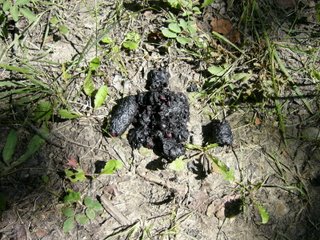
This is a photo of Coyote scat found on the Wishart Trail in the Gaetz Lakes Sanctuary this afternoon.
Some concerned visitors spotted it earlier in the day and were wondering if a bear had indeed done what bears are reputed to do in the woods.
At this time of year it's an easy mistake to make. Coyotes in late summer become very omnivorous; consuming berries, leaves, decaying animals and prey they themselves have killed. This combination of foods, especially the berry content, makes scat that very much resembles bear droppings.
The keys to identifying these souvenirs as being left behind by a coyote and not a bear are the shape of the individual scats and the size of deposit. This sample is much smaller and better formed than anything a Black Bear would excrete.
Coyotes, foxes, moose, deer and other mammals are all consuming sugar-rich berries at this time of year. This means that almost everything is leaving scats that resemble bear droppings.
Labels:
animals
Sunday, August 13, 2006
Seen in the Sanctuary:
 Ripe Chokecherries on the trail to the bird blind.
Ripe Chokecherries on the trail to the bird blind. Female Thin-Legged Wolf Spider camouflaged beside the edge of the path.
Female Thin-Legged Wolf Spider camouflaged beside the edge of the path. Kerry Wood Nature Centre from the Dr. George Trail.
Kerry Wood Nature Centre from the Dr. George Trail.
Labels:
animals,
Nature Centre,
plants,
sanctuary
Thursday, August 03, 2006
Walking McKenzie
I was down at McKenzie Trail Recreation Area for a little while this afternoon. For those of you who aren't familiar with the park, it's the next one down the bike trail from the Nature Centre and is quite a nice picnic spot. McKenzie Trail park consists partly of a reclaimed gravel pit which has been turned into a nesting pond that is very popular with the local goose and duck population.

McKenzie's a favourite place with those who enjoy feeding geese, but I'd ask that you consider feeding them something other than bread. Bread's actually pretty tough for those birds to digest in large quantities. If you're looking for alternative foods, you might try dried peas or cracked corn. The Nature Centre Bookstore sells small bags of corn for a dollar.

Across the road from the pond is one of the lesser-known trails in Waskasoo Park. The loop at McKenzie isn't very long (it can easily be walked in twenty minutes), but it winds its way through some very interesting plant communities. My favourite is one of the few old growth White Spruce forests in Red Deer. The forest is quiet but not as dark as a younger conifer stand.
As you walk through McKenzie, see if you can spot the traces of last year's flood. McKenzie ended up as part of the river last June, but it's amazing to see how quickly the river silt is being covered up by new plant growth.

McKenzie's a favourite place with those who enjoy feeding geese, but I'd ask that you consider feeding them something other than bread. Bread's actually pretty tough for those birds to digest in large quantities. If you're looking for alternative foods, you might try dried peas or cracked corn. The Nature Centre Bookstore sells small bags of corn for a dollar.

Across the road from the pond is one of the lesser-known trails in Waskasoo Park. The loop at McKenzie isn't very long (it can easily be walked in twenty minutes), but it winds its way through some very interesting plant communities. My favourite is one of the few old growth White Spruce forests in Red Deer. The forest is quiet but not as dark as a younger conifer stand.
As you walk through McKenzie, see if you can spot the traces of last year's flood. McKenzie ended up as part of the river last June, but it's amazing to see how quickly the river silt is being covered up by new plant growth.
Wednesday, July 26, 2006
Spittlebugs and other things
 Keen observers might notice that some of the plants beside the Sanctuary paths look like someone's been rather rudely clearing his throat onto them. The fact is that we really don't need to be putting up "No Spitting" signs -- what looks like spit is actually the home of the nymph of the aptly-named Spittlebug. The foamy covering the nymph produces helps hide it and protects it from predators.
Keen observers might notice that some of the plants beside the Sanctuary paths look like someone's been rather rudely clearing his throat onto them. The fact is that we really don't need to be putting up "No Spitting" signs -- what looks like spit is actually the home of the nymph of the aptly-named Spittlebug. The foamy covering the nymph produces helps hide it and protects it from predators.I was able to get out for a brief walk on the Dr. George Trail this afternoon, and it was interesting to see that even in the hot, muggy weather we've been having things were still pretty busy in the grassland. In the grassland, she says? Well, yes. I know it can look like one of the blander parts of the Sanctuary, but this time of year it's actually got quite a lot going on. You just have to look at things on a smaller scale.
The goldenrod, asters, and (sigh) thistles have brought out the butterflies in decent numbers, for one thing. I'm not at my best with butterfly IDs, but even I could find wood nymphs, sulphurs, and fritillaries darting from flower to flower.
This is also grasshopper season, and while grasshoppers may not be appreciated in a crop I find it a very summery experience to walk through the meadow and hear them buzzing.
I suppose all this is by way of saying that even when the large animals are off in the quiet and shade of the forest, there's still a lot of life to be seen if you take a moment to look at things a little differently.
See you out on the path!
Monday, July 17, 2006
Template Addition
For those of you interested in the state of the Red Deer River - and other rivers in the Red Deer River Basin - I've added a link to the Alberta Government's river basin information map. It's located just to the right of the page in the sidebar.
For example: by selecting the Red Deer River Sub-Basin and selecting River Flows and Levels, you can generate a graph that shows historical and current streamflows for the Red Deer River. This is particularly helpful for getting an idea how fast or deep the river is running before you plan you canoe, kayak or float trip on our rivers.
The photo below is a snapshot of a typical streamflow graph.

For example: by selecting the Red Deer River Sub-Basin and selecting River Flows and Levels, you can generate a graph that shows historical and current streamflows for the Red Deer River. This is particularly helpful for getting an idea how fast or deep the river is running before you plan you canoe, kayak or float trip on our rivers.
The photo below is a snapshot of a typical streamflow graph.

Labels:
environment
Friday, July 14, 2006
Recent spider photos
I haven't posted any spider pictures lately, so here are a few in one go. As always, just click on the photo to enlarge it.
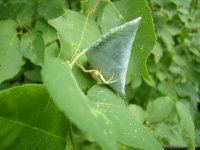 I was lucky enough to snap this shot yesterday when I was out on the Dr. George trail in the Sanctuary. It's a female Goldenrod Spider (Misumena vatia) defending her egg sac. These spiders are ambush predators and don't use webs for catching insects, but they do use silk to wrap up the leaf they've chosen to cache their eggs in. This crab spider will spend the rest of her life defending her egg sac; in fact, she's likely to die of starvation (or exhaustion) before the spiderlings hatch out.
I was lucky enough to snap this shot yesterday when I was out on the Dr. George trail in the Sanctuary. It's a female Goldenrod Spider (Misumena vatia) defending her egg sac. These spiders are ambush predators and don't use webs for catching insects, but they do use silk to wrap up the leaf they've chosen to cache their eggs in. This crab spider will spend the rest of her life defending her egg sac; in fact, she's likely to die of starvation (or exhaustion) before the spiderlings hatch out.
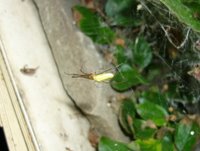 Earlier this week I had a chance to watch this spider at work beside my father's fish pond. It's a Long-Jawed Orb Weaver (Tetragnatha sp.). The Long-Jawed Orb Weaver builds a typical-looking orb web, but it's often on a bit of a tilt and has the middle hub removed so that the spider can cross from side to side. Long-Jawed Orb Weavers can be found near wetlands (amongst other places), and will stretch out their long, skinny bodies to camouflage themselves in the reeds. This one didn't have any reeds nearby to hide in, but the cotoneaster leaves in the background should give you an idea of its size.
Earlier this week I had a chance to watch this spider at work beside my father's fish pond. It's a Long-Jawed Orb Weaver (Tetragnatha sp.). The Long-Jawed Orb Weaver builds a typical-looking orb web, but it's often on a bit of a tilt and has the middle hub removed so that the spider can cross from side to side. Long-Jawed Orb Weavers can be found near wetlands (amongst other places), and will stretch out their long, skinny bodies to camouflage themselves in the reeds. This one didn't have any reeds nearby to hide in, but the cotoneaster leaves in the background should give you an idea of its size.
 Since I was planning to post the first two spiders, I thought I may as well include a photo I took last week too. It looks a bit less than natural compared to the other two, but that's just because I sneaked a piece of paper behind the spider so that its markings would show up better. It's called a Bowl-and-Doily Spider (Frontinella communis) and is a member of the Linyphiidae or Sheet Weaver family. The web this spider builds is quite remarkable. The top part looks like an upside-down bowl, and it's suspended above a flat-sheet "doily". The web isn't sticky, but is enough to hinder any small insects that fall on it long enough for the spider to bite through the web and drag its prey under. The Bowl-and-Doily Spider's markings often look a bit like a cursive "mc".
Since I was planning to post the first two spiders, I thought I may as well include a photo I took last week too. It looks a bit less than natural compared to the other two, but that's just because I sneaked a piece of paper behind the spider so that its markings would show up better. It's called a Bowl-and-Doily Spider (Frontinella communis) and is a member of the Linyphiidae or Sheet Weaver family. The web this spider builds is quite remarkable. The top part looks like an upside-down bowl, and it's suspended above a flat-sheet "doily". The web isn't sticky, but is enough to hinder any small insects that fall on it long enough for the spider to bite through the web and drag its prey under. The Bowl-and-Doily Spider's markings often look a bit like a cursive "mc".
Each of these spiders is harmless to humans, as are the vast majority of spiders here in Alberta.
We don't have a resident spider expert at the Nature Centre, but if you have spider (or other) questions please don't hesitate to give us a call. We'll do our best to see what information we can find for you.
 I was lucky enough to snap this shot yesterday when I was out on the Dr. George trail in the Sanctuary. It's a female Goldenrod Spider (Misumena vatia) defending her egg sac. These spiders are ambush predators and don't use webs for catching insects, but they do use silk to wrap up the leaf they've chosen to cache their eggs in. This crab spider will spend the rest of her life defending her egg sac; in fact, she's likely to die of starvation (or exhaustion) before the spiderlings hatch out.
I was lucky enough to snap this shot yesterday when I was out on the Dr. George trail in the Sanctuary. It's a female Goldenrod Spider (Misumena vatia) defending her egg sac. These spiders are ambush predators and don't use webs for catching insects, but they do use silk to wrap up the leaf they've chosen to cache their eggs in. This crab spider will spend the rest of her life defending her egg sac; in fact, she's likely to die of starvation (or exhaustion) before the spiderlings hatch out. Earlier this week I had a chance to watch this spider at work beside my father's fish pond. It's a Long-Jawed Orb Weaver (Tetragnatha sp.). The Long-Jawed Orb Weaver builds a typical-looking orb web, but it's often on a bit of a tilt and has the middle hub removed so that the spider can cross from side to side. Long-Jawed Orb Weavers can be found near wetlands (amongst other places), and will stretch out their long, skinny bodies to camouflage themselves in the reeds. This one didn't have any reeds nearby to hide in, but the cotoneaster leaves in the background should give you an idea of its size.
Earlier this week I had a chance to watch this spider at work beside my father's fish pond. It's a Long-Jawed Orb Weaver (Tetragnatha sp.). The Long-Jawed Orb Weaver builds a typical-looking orb web, but it's often on a bit of a tilt and has the middle hub removed so that the spider can cross from side to side. Long-Jawed Orb Weavers can be found near wetlands (amongst other places), and will stretch out their long, skinny bodies to camouflage themselves in the reeds. This one didn't have any reeds nearby to hide in, but the cotoneaster leaves in the background should give you an idea of its size. Since I was planning to post the first two spiders, I thought I may as well include a photo I took last week too. It looks a bit less than natural compared to the other two, but that's just because I sneaked a piece of paper behind the spider so that its markings would show up better. It's called a Bowl-and-Doily Spider (Frontinella communis) and is a member of the Linyphiidae or Sheet Weaver family. The web this spider builds is quite remarkable. The top part looks like an upside-down bowl, and it's suspended above a flat-sheet "doily". The web isn't sticky, but is enough to hinder any small insects that fall on it long enough for the spider to bite through the web and drag its prey under. The Bowl-and-Doily Spider's markings often look a bit like a cursive "mc".
Since I was planning to post the first two spiders, I thought I may as well include a photo I took last week too. It looks a bit less than natural compared to the other two, but that's just because I sneaked a piece of paper behind the spider so that its markings would show up better. It's called a Bowl-and-Doily Spider (Frontinella communis) and is a member of the Linyphiidae or Sheet Weaver family. The web this spider builds is quite remarkable. The top part looks like an upside-down bowl, and it's suspended above a flat-sheet "doily". The web isn't sticky, but is enough to hinder any small insects that fall on it long enough for the spider to bite through the web and drag its prey under. The Bowl-and-Doily Spider's markings often look a bit like a cursive "mc".Each of these spiders is harmless to humans, as are the vast majority of spiders here in Alberta.
We don't have a resident spider expert at the Nature Centre, but if you have spider (or other) questions please don't hesitate to give us a call. We'll do our best to see what information we can find for you.
Labels:
animals
Friday, July 07, 2006
Saskatoons
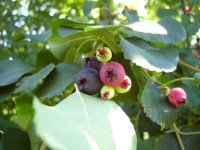 I grew up helping my grandmother pick saskatoons (Amelanchier alnifolia) for pies and preserves, and even though I rarely do anything with them but eat them straight off the bush these days I still look forward to berry-picking season.
I grew up helping my grandmother pick saskatoons (Amelanchier alnifolia) for pies and preserves, and even though I rarely do anything with them but eat them straight off the bush these days I still look forward to berry-picking season.That's funny, actually, because saskatoons aren't really berries. They're technically known as pomes, and if you had the patience to dissect one (rather than just eat it) you'd find all of the same structures inside a saskatoon as you do in an apple.
Judging by the looks of the earliest-ripening fruits, I'd say that our saskatoon season is going to be a decent one this year. Which brings me to the reason for this post...
If you had planned to come to the Nature Centre to walk in the Gaetz Lakes Sanctuary with your berry-picking bucket, you might do better to leave the bucket at home and just go for the walk. While we don't mind visitors sampling one or two saskatoons as they go, we'd prefer that most of the pomes in the Sanctuary be left for the many animals that depend on them.
Also, a reminder to those who like to collect saskatoons and other fruit from the bushes along 45th Avenue on the way to the Nature Centre: please take extra care to park your car safely. The road's fairly narrow, and over the years I've seen my share of near-misses on that stretch during picking season.
Happy (and safe) harvest, everyone!
Labels:
plants
Monday, June 26, 2006
Black Powder and Red Insects
First, our thanks to everybody who attended and/or participated in this past weekend's FortFest at Fort Normandeau. Once again contributions from our volunteers, the Firestick Society, the Red Deer aboriginal Dance Troupe and the 65th Mount Royal Rifles Commemorative Regiment were invaluable and, as always, entertaining.
Aside: If anybody atteding FortFest on Sunday got a photo of the outstanding smoke ring created by the 65th's cannon, please get in touch with us. We'd really like a copy of the image.
In the "Seen in the Park" vein, we had one of the areas neatest and more secretive insects brought into us last week. The critter below is an Elm Sawfly, Cimbex americana. While it's somewhat ferocious looking - especially when it's held in an outstretched, empty Gatorade bottle - this large insect is completely harmless. It is a hymenopteran like wasps, bees and hornets, but sawflies have no stinger. If you're really diligent and somewhat lucky, you can find Elm Sawflies resting in the summer sun on the branches of willow, elm and poplars; often along watercourses.
Due to the significant damage they cause to their host Elm trees, Elm Sawfly larvae are considered an agricultural pest.
Aside: If anybody atteding FortFest on Sunday got a photo of the outstanding smoke ring created by the 65th's cannon, please get in touch with us. We'd really like a copy of the image.
In the "Seen in the Park" vein, we had one of the areas neatest and more secretive insects brought into us last week. The critter below is an Elm Sawfly, Cimbex americana. While it's somewhat ferocious looking - especially when it's held in an outstretched, empty Gatorade bottle - this large insect is completely harmless. It is a hymenopteran like wasps, bees and hornets, but sawflies have no stinger. If you're really diligent and somewhat lucky, you can find Elm Sawflies resting in the summer sun on the branches of willow, elm and poplars; often along watercourses.
Due to the significant damage they cause to their host Elm trees, Elm Sawfly larvae are considered an agricultural pest.

Elm Sawfly, Cimbex americana
Hi Sharn
Labels:
animals,
programs and events
Wednesday, June 21, 2006
New at the Centre
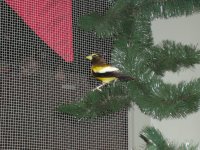 The latest addition to our critter collection at the Nature Centre is currently making himself at home in the bird cage. The Evening Grosbeak was brought to Medicine River Wildlife Centre with a wing injury, and since he was non-releasable he'll be living here at the Nature Centre. He's really a beautiful bird, and I hope everyone will drop by to have a look at him.
The latest addition to our critter collection at the Nature Centre is currently making himself at home in the bird cage. The Evening Grosbeak was brought to Medicine River Wildlife Centre with a wing injury, and since he was non-releasable he'll be living here at the Nature Centre. He's really a beautiful bird, and I hope everyone will drop by to have a look at him. If you do come down to the Nature Centre to visit the Grosbeak (or look at the displays or take a walk or browse the bookstore...), be sure to take a moment and look at the Prickly Pear Cactus bed beside our back door (the staff entrance). The cactus flowers are just starting to come out, and when the whole bed's in bloom the waxy-looking flowers make for quite a show.
If you do come down to the Nature Centre to visit the Grosbeak (or look at the displays or take a walk or browse the bookstore...), be sure to take a moment and look at the Prickly Pear Cactus bed beside our back door (the staff entrance). The cactus flowers are just starting to come out, and when the whole bed's in bloom the waxy-looking flowers make for quite a show.
Tuesday, June 13, 2006
Blue-Eyed Grass
 Sharp-eyed park visitors may find that some of our grass seems to have very ungrasslike flowers. The truth is that the flower is not actually on a grass, but on a member of the Iris family known as Blue-Eyed Grass (Sisyrinchium montanum) because of its grass-like leaves.
Sharp-eyed park visitors may find that some of our grass seems to have very ungrasslike flowers. The truth is that the flower is not actually on a grass, but on a member of the Iris family known as Blue-Eyed Grass (Sisyrinchium montanum) because of its grass-like leaves.You may not even notice Blue-Eyed Grass flowers at first because they're not very big and tend to blend into the surrounding grass fairly well, but once you've spotted your first flower you'll start to find them on the grassy edges of paths throughout Waskasoo Park.
Labels:
plants
Friday, June 02, 2006
Peregrine Falcon Webcam
The University of Alberta's Peregrine Falcon Webcam is showing that the Peregrines on the Clinical Sciences Building are currently incubating four eggs. The eggs should hatch mid-June.
The images on the webcams update every fifteen seconds. It's worth a look!
The images on the webcams update every fifteen seconds. It's worth a look!
Labels:
animals
Thursday, June 01, 2006
Spring smells
 If you were to go for a walk on the Dr. George Trail today, I don't think you'd be able to not notice the start of the wild rose bloom. Rosa acicularis is, of course, Alberta's provincial flower, but it's also one of my personal favourites. The wild rose may not be as showy as a hybrid tea rose, but it's hardy, fragrant, and actually has a very high nutritive value. In a few days' time the walk towards the bird blind trail should smell better than any perfume counter.
If you were to go for a walk on the Dr. George Trail today, I don't think you'd be able to not notice the start of the wild rose bloom. Rosa acicularis is, of course, Alberta's provincial flower, but it's also one of my personal favourites. The wild rose may not be as showy as a hybrid tea rose, but it's hardy, fragrant, and actually has a very high nutritive value. In a few days' time the walk towards the bird blind trail should smell better than any perfume counter.Right now, though, it smells more like somebody mixed up far too many perfume-counter samples at once. The culprit isn't the roses, but the small yellow flowers on the Silverberry (better known to some as Wolf Willow) bushes.
 It's hard to believe that the Silverberry's tiny, nearly inconspicuous flowers can raise such a big stink, but there's a pretty good reason for it. The plant depends on insects to pollinate its flowers, and scents are quite effective at attracting them. Generally speaking, sweet smells attract bees and butterflies, while rotten smells attract flies.
It's hard to believe that the Silverberry's tiny, nearly inconspicuous flowers can raise such a big stink, but there's a pretty good reason for it. The plant depends on insects to pollinate its flowers, and scents are quite effective at attracting them. Generally speaking, sweet smells attract bees and butterflies, while rotten smells attract flies.Many people like the smell of Silverberry, while others find it a bit on the overpowering side. Count me in with the latter group, I suppose, but I'll be happy when the Silverberry's done and the roses are front and centre.
Labels:
plants
Tuesday, May 16, 2006
Spring birding
Here are a few thoughts from Jim on what's happening in the bird world right now:
This is the start of "shorebird season" -- look to sloughs and the muddy shores of shallow lakes for things like sandpipers and yellowlegs.
Snipe are winnowing -- that is, making their weird sound as they dive through the air (over and over and over and ...!) in their mating / territorial flights.
Goldfinches, the native sparrows and the birds that catch flying insects -- flycatchers, swallows, peewees, phoebes, kingbirds -- are here now too. We haven't seen many warblers yet, however.
Any waxwings you see these days are likely to be cedar waxwings: the Bohemians have, for the most part, migrated away until Thanksgiving.
And, it's time to put up your hummingbird feeders! Call the Nature Centre at 346-2010 for a recipe for do-it-yourself hummingbird nectar.
This is the start of "shorebird season" -- look to sloughs and the muddy shores of shallow lakes for things like sandpipers and yellowlegs.
Snipe are winnowing -- that is, making their weird sound as they dive through the air (over and over and over and ...!) in their mating / territorial flights.
Goldfinches, the native sparrows and the birds that catch flying insects -- flycatchers, swallows, peewees, phoebes, kingbirds -- are here now too. We haven't seen many warblers yet, however.
Any waxwings you see these days are likely to be cedar waxwings: the Bohemians have, for the most part, migrated away until Thanksgiving.
And, it's time to put up your hummingbird feeders! Call the Nature Centre at 346-2010 for a recipe for do-it-yourself hummingbird nectar.
Labels:
animals
Wednesday, May 10, 2006
Seen in the Sanctuary
 I had a chance to get out on the Dr. George Trail briefly this morning. It was fairly quiet out there -- or at least as far as human visitors go, it was quiet. Things are full-on spring noisy in the animal world. If you head out to one of the lake viewing decks you'll likely be treated to quite a show, between the Red-Winged Blackbirds defending territory and the various waterfowl choosing mates or nesting sites.
I had a chance to get out on the Dr. George Trail briefly this morning. It was fairly quiet out there -- or at least as far as human visitors go, it was quiet. Things are full-on spring noisy in the animal world. If you head out to one of the lake viewing decks you'll likely be treated to quite a show, between the Red-Winged Blackbirds defending territory and the various waterfowl choosing mates or nesting sites. It's definitely spring in the plant community as well. Most of the trees and shrubs have leafed out now, and early flowerers like this Chokecherry are starting to bud. No doubt anyone who's been out on any of the Red Deer trails has noticed that the Balsam Poplars are shedding their winter bud covers. Those are the pointy brown "stickies" that we'll all be pulling off of our shoes, cars, and pets for the next couple of weeks.
It's definitely spring in the plant community as well. Most of the trees and shrubs have leafed out now, and early flowerers like this Chokecherry are starting to bud. No doubt anyone who's been out on any of the Red Deer trails has noticed that the Balsam Poplars are shedding their winter bud covers. Those are the pointy brown "stickies" that we'll all be pulling off of our shoes, cars, and pets for the next couple of weeks.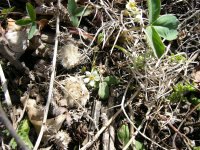 For me, a real sign of spring is finding my first Early Blue Violet and my first Wild Strawberry flower. Keep an eye on the sun-warmed margins of the paths throughout the park for these early beauties.
For me, a real sign of spring is finding my first Early Blue Violet and my first Wild Strawberry flower. Keep an eye on the sun-warmed margins of the paths throughout the park for these early beauties.Remember, if you happen to be out on the trails anywhere in the city and notice one of the Nature Centre's naturalists walking along, we'd be more than happy to answer any of your nature or history questions. And if we don't have the answer, we'll certainly give you a hand finding it.
Saturday, April 29, 2006
Walking the Wishart
I was out on the 4 km (Wishart) trail fairly early this morning, and for the first time this season (terrible to have to admit that).
Now that the days have warmed up a bit, morning is actually a great time to get out for a walk. The birds are usually more active than they are in the afternoon, and the trails themselves tend to be less busy than they get later in the day.
Spring walkers will notice that green is definitely starting to peek out from under last year's dead grasses. Many of the deciduous trees are budding as well. It's interesting to see, though, that even with the warmth we've had lately the mineral springs are still frozen and are likely to remain that way for a few weeks yet.
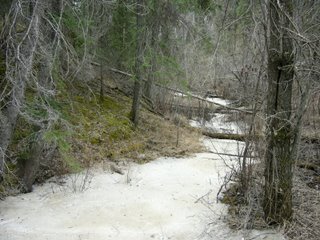
One of my more intriguing finds this morning was the beaver-chewed stump you see below:

And why on earth is a chewed stump intriguing? Well, for at least two years now we've had no sign of beaver activity in the Sanctuary at all. I think they probably moved on to greener pastures (or at least the river) when the water level in the lakes was so low during the drought. A freshly chewed stump is a pretty clear indication that they're back again. This one was very close to the far viewing deck on the West Lake. I'd expect to see the beavers doing repairs on the existing lodge across from the viewing deck if that's where they're hanging out, so make sure you keep an eye open for them.
Now that the days have warmed up a bit, morning is actually a great time to get out for a walk. The birds are usually more active than they are in the afternoon, and the trails themselves tend to be less busy than they get later in the day.
Spring walkers will notice that green is definitely starting to peek out from under last year's dead grasses. Many of the deciduous trees are budding as well. It's interesting to see, though, that even with the warmth we've had lately the mineral springs are still frozen and are likely to remain that way for a few weeks yet.

One of my more intriguing finds this morning was the beaver-chewed stump you see below:

And why on earth is a chewed stump intriguing? Well, for at least two years now we've had no sign of beaver activity in the Sanctuary at all. I think they probably moved on to greener pastures (or at least the river) when the water level in the lakes was so low during the drought. A freshly chewed stump is a pretty clear indication that they're back again. This one was very close to the far viewing deck on the West Lake. I'd expect to see the beavers doing repairs on the existing lodge across from the viewing deck if that's where they're hanging out, so make sure you keep an eye open for them.
Tuesday, April 25, 2006
Wind!!
And lots of it. I'm sitting at the front counter watching the very large spruce trees blow around like flags in the wind. Keep your eyes open and your head up while walking both on our trails and anywhere there are trees overhead. In the past we've had entire trees come down in the wind. I'm pretty sure that our regular trail walkers will be to report blown down trees and branches before the day is over.
More importantly, the wind is helping to disperse pollen and seeds, assisting in plant reproduction. During last year's big spring and summer winds we watched massive clouds of pollen blowing off the spruce trees.
Check out our article in the Sunday Red Deer Life.
Keep you hand on your hat. It's a good day for flying kites and watching the clouds race across the sky.
More importantly, the wind is helping to disperse pollen and seeds, assisting in plant reproduction. During last year's big spring and summer winds we watched massive clouds of pollen blowing off the spruce trees.
Check out our article in the Sunday Red Deer Life.
Keep you hand on your hat. It's a good day for flying kites and watching the clouds race across the sky.
Labels:
environment
Monday, April 24, 2006
Life at the pond
I took a quick walk down the road to McKenzie Trail this morning to see how the clean-up after last summer's flood has come along. The park should be open to the public again in the first part of May, and we at the Nature Centre are looking forward to doing pond studies with grade five students down there this spring.

It's a bit of a windy day today, but the goose population out on the nesting islands doesn't seem to be especially concerned. The robins are busily hunting all over the park, and down towards the parking lot I could hear the phoebe calling (thanks for the heads-up on that one, Judy).
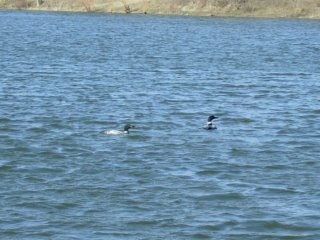
The loons seem to have moved back as well. Judy was saying that last year's nest had been washed out in the flood and she thought they may have decided to try Three Mile Bend this time instead, but this morning they were happily diving at McKenzie again. Considering the amount of river water that passed through the ponds last year, the birds may be finding interesting new sources of food there now.

It's a bit of a windy day today, but the goose population out on the nesting islands doesn't seem to be especially concerned. The robins are busily hunting all over the park, and down towards the parking lot I could hear the phoebe calling (thanks for the heads-up on that one, Judy).

The loons seem to have moved back as well. Judy was saying that last year's nest had been washed out in the flood and she thought they may have decided to try Three Mile Bend this time instead, but this morning they were happily diving at McKenzie again. Considering the amount of river water that passed through the ponds last year, the birds may be finding interesting new sources of food there now.
Labels:
animals
Sunday, April 09, 2006
Check out the Eagle!
Here is a live cam of a bald eagle nest on Hornby Island - just off of Vancouver Island, B.C. It's really cool!
Labels:
animals
Saturday, April 01, 2006
Happy April
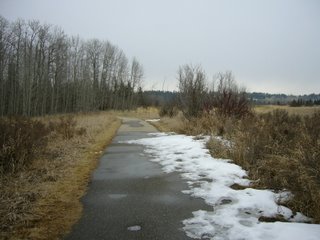
As you can see, it's finally starting to look less like winter out there. Not that I'm counting out another storm since this is Alberta (I am knocking wood as I type this), but even pessimistic me had to admit that it felt like spring this morning.
A chilly, breezy spring, yes. But spring nonetheless.

It's starting to sound like spring as well. The geese are very vocally reminding us that they're back, many other birds are setting territory, and the red squirrels (sorry for the slightly fuzzy shot. It was a quick hand-held zoom snap)... well, the red squirrels are as obnoxious as ever.
I mean that in a good way. I like red squirrels, but I'm the first to admit that between fighting with each other and chattering at every other animal or person who happens to pass by, they're not exactly calm neighbours.
Staying with the squirrels, our Richardson's Ground Squirrels (better known to most as gophers) have emerged from hibernation and are busily searching out anything remotely edible out there.
Yep, it's definitely spring. That doesn't mean, though, that we don't still have a bit of winter out on the trails. If you're going out for a walk, please be careful of the occasional icy patches still to be found in shaded areas.
And speaking of walks, be sure to drop by the Nature Centre on Saturday, April 8th for our Birds and Buds walk. We'll be looking and listening for signs of spring in the Gaetz Lakes Sanctuary. The walk leaves the Nature Centre at 1:00 p.m. Please be sure to dress for the weather.
As always, give us a call at (403)346-2010 for information on this or any other Nature Centre program or event.
Labels:
animals,
programs and events
Tuesday, February 28, 2006
Let it snow :)
It has come at last... snow!! Bring out the sleds, skis, or my favorite... snowshoes!! If you don't have a pair of snowshoes, feel free to come on down to the nature centre and rent one of ours. We will show you how to put them on, give you some tips for your trip all for the low cost of $2.00 per person per hour. Or you can rent them for the day and take them elsewhere in the Waskasoo Park System or out of town. If you are snowshoeing in the Gaetz Lake Sanctuary, please make sure you still stay on the trails. Thanks and have fun while it lasts.
Labels:
Nature Centre
Thursday, January 26, 2006
Flying in the sky!
such wonderful reasons to look up! A visitor just told me of how he just saw a Cooper's Hawk not 20 ft flying above and it reminded me of not one week ago when I was walking to work and saw a bald eagle flying just over the 67th St bridge. So take a look up once in awhile - it just might be as beautiful as stopping to smell the flowers :)
Labels:
animals
Tuesday, January 17, 2006
Job Posting - DayCamps
Open Competition:
Day Camp Coordinator
The Normandeau Cultural and Natural History Society, a non-profit charitable society which operates the Waskasoo Park Interpretive Program on contract for The City of Red Deer, has one position available for the coming summer as a Day Camp Coordinator.
Based at Red Deer's Historic Fort Normandeau and the Kerry Wood Nature Centre, the successful applicant will provide living, cultural history and natural history activities to day camp and sleepover participants. The position also entails assisting the Park Interpreters with their programming, and related duties such as planning, program preparation/cleanup, research and dressing in period costume to deliver living history and natural history programs.
Essential Qualifications:
· excellent public communication/drama skills and experience with/love for working with the public (including seniors, adults and children);
· post-secondary education in western Canadian history and/or biological sciences, education or interpretation
· an excellent knowledge of the sights, attractions, major events, roads and parks of Red Deer, including the bike trails of Waskasoo Park;
· current first aid/C.P.R. certificates;
· a valid driver's permit and reliable transportation;
· a neat appearance and the willingness to wear the Park uniform and period costumes properly, and to abide by the NCNHS's smoking and other policies;
· the ability to work cooperatively with other staff and volunteers;
· willingness and ability to stay the entire term of this position;
· willingness and ability to work most or all weekends and evenings;
· good health: some lifting is required;
· good organizational skills and the ability to plan your schedule and workload;
· basic knowledge of the human history of central Alberta.
Desirable Qualities:
· experience and training in drama;
· experience in art, traditional crafts (e.g. poultry or other livestock husbandry, baking, quilting, candle-, ice cream-, rope- or soap-making, sewing, spinning/weaving, animal husbandry, fence building, carpentry, wheel- or barrel-making, gardening, etc.)
· experience with computers (Windows environment): word processing, spreadsheets, database, desktop publishing;
· ability to cook on and bake in a wood-fired stove;
· knowledge of the natural history of central Alberta.
· retail sales experience;
Wages, Term and Conditions of Employment:
· June 26 to September 1, 2006, inclusive.
· This is a full-time summer position (37.5 hours/week, for 10 weeks)
· One position is available.
· Accommodation is not provided.
· Regular evening and weekend work is required.
To Apply:
Apply in writing by March 10, 2006 to:
Manager, Waskasoo Park Interpretive Program
6300-45th Avenue
Red Deer, AB
T4N 3M4
Fax: 403 347-2550
email: programs@waskasoopark.ca
Include a résumé outlining related experience and references, and a brief letter explaining why the position is of interest to you. No phone calls, please. Applicants selected for an interview will be contacted.
Day Camp Coordinator
The Normandeau Cultural and Natural History Society, a non-profit charitable society which operates the Waskasoo Park Interpretive Program on contract for The City of Red Deer, has one position available for the coming summer as a Day Camp Coordinator.
Based at Red Deer's Historic Fort Normandeau and the Kerry Wood Nature Centre, the successful applicant will provide living, cultural history and natural history activities to day camp and sleepover participants. The position also entails assisting the Park Interpreters with their programming, and related duties such as planning, program preparation/cleanup, research and dressing in period costume to deliver living history and natural history programs.
Essential Qualifications:
· excellent public communication/drama skills and experience with/love for working with the public (including seniors, adults and children);
· post-secondary education in western Canadian history and/or biological sciences, education or interpretation
· an excellent knowledge of the sights, attractions, major events, roads and parks of Red Deer, including the bike trails of Waskasoo Park;
· current first aid/C.P.R. certificates;
· a valid driver's permit and reliable transportation;
· a neat appearance and the willingness to wear the Park uniform and period costumes properly, and to abide by the NCNHS's smoking and other policies;
· the ability to work cooperatively with other staff and volunteers;
· willingness and ability to stay the entire term of this position;
· willingness and ability to work most or all weekends and evenings;
· good health: some lifting is required;
· good organizational skills and the ability to plan your schedule and workload;
· basic knowledge of the human history of central Alberta.
Desirable Qualities:
· experience and training in drama;
· experience in art, traditional crafts (e.g. poultry or other livestock husbandry, baking, quilting, candle-, ice cream-, rope- or soap-making, sewing, spinning/weaving, animal husbandry, fence building, carpentry, wheel- or barrel-making, gardening, etc.)
· experience with computers (Windows environment): word processing, spreadsheets, database, desktop publishing;
· ability to cook on and bake in a wood-fired stove;
· knowledge of the natural history of central Alberta.
· retail sales experience;
Wages, Term and Conditions of Employment:
· June 26 to September 1, 2006, inclusive.
· This is a full-time summer position (37.5 hours/week, for 10 weeks)
· One position is available.
· Accommodation is not provided.
· Regular evening and weekend work is required.
To Apply:
Apply in writing by March 10, 2006 to:
Manager, Waskasoo Park Interpretive Program
6300-45th Avenue
Red Deer, AB
T4N 3M4
Fax: 403 347-2550
email: programs@waskasoopark.ca
Include a résumé outlining related experience and references, and a brief letter explaining why the position is of interest to you. No phone calls, please. Applicants selected for an interview will be contacted.
Labels:
Employment
Subscribe to:
Posts (Atom)
